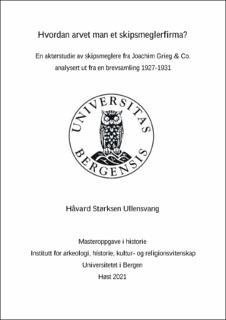| dc.contributor.author | Ullensvang, Håvard Størksen | |
| dc.date.accessioned | 2021-12-15T07:33:49Z | |
| dc.date.issued | 2021-11-23 | |
| dc.date.submitted | 2021-12-14T23:00:07Z | |
| dc.identifier.uri | https://hdl.handle.net/11250/2834301 | |
| dc.description.abstract | The aim of this thesis is to analyze a collection of letters written by Joachim Grieg & Co.’s co-owner Halfdan Grieg senior to his son Halfdan Grieg junior throughout 1927-1931. To that end, the thesis question is divided into three components. i: What do the letters reveal about Halfdan Grieg junior’s formative journey 1927-1931? ii: What characterizes the letters that Halfdan Grieg senior wrote in the same time period? iii: What do the letters reveal about Joachim Grieg & Co.’s firm development in the same time period? The structure is defined by the contents and periodization of the letters. Therefore, two analytical chapters seeks to discuss the thesis question. The first part of the analysis covers the 1927-1928 years of Halfdan Grieg junior’s journey, while he was in New York. The second part covers the period when he was primarily in Hamburg and London 1929-1931. It is argued for, in this paper, that the findings are both interesting and plentiful. The plethora of letters ranging over 400 pages are tight-knit and weave events that transpire between these two historical actors. Halfdan Grieg junior discovered the shipbroker life first-hand and returned in 1931 to inherit his fathers’ position in the firm. His father both acted to correct and encourage him. The duality of these letters was Halfdan Grieg senior’s changing roles: from father to employer. This is argued to be a trait of semiformal letters, and part of what it meant to be a family-owned maritime firm at the time. Meanwhile, the Grieg-firm was in a negative spiral that started in the 1920s. This was due to a shipping crisis that hit Norway at the start of the decade that caused a short term collapse of the freight market. Long term, the country would go on to recover and thrive during the interwar period, but this was not the case for the Grieg-firm. Their main goal through the period was to stabilize their finances and proceed cautiously. As Halfdan Grieg junior gained experience as a shipbroker, he would go on to represent the firm in establishing new markets and help the firm recover. | |
| dc.language.iso | nob | |
| dc.publisher | The University of Bergen | |
| dc.rights | Copyright the Author. All rights reserved | |
| dc.subject | Skipsmegling | |
| dc.subject | Brevkilde | |
| dc.subject | Skipsfart | |
| dc.subject | Maritim Historie | |
| dc.subject | Aktørstudie | |
| dc.title | Hvordan arvet man et skipsmeglerfirma? En aktørstudie av skipsmeglere fra Joachim Grieg & Co. analysert ut fra en brevsamling 1927-1931 | |
| dc.type | Master thesis | |
| dc.date.updated | 2021-12-14T23:00:07Z | |
| dc.rights.holder | Copyright the Author. All rights reserved | |
| dc.description.degree | Historie mastergradsoppgave | |
| dc.description.localcode | HIS350 | |
| dc.description.localcode | MAHF-LÆHR | |
| dc.description.localcode | MAHF-HIS | |
| dc.subject.nus | 713107 | |
| fs.subjectcode | HIS350 | |
| fs.unitcode | 11-22-0 | |
